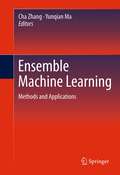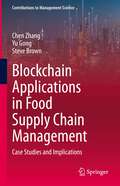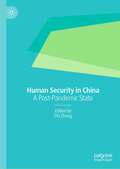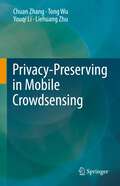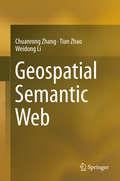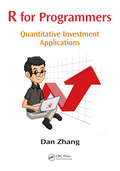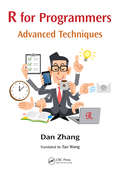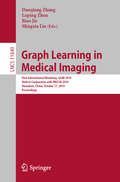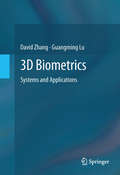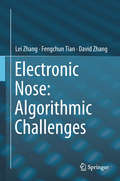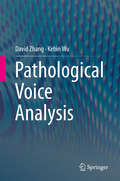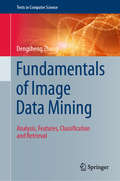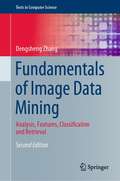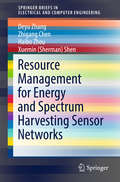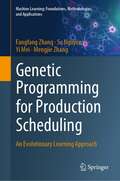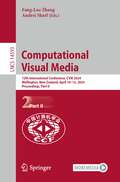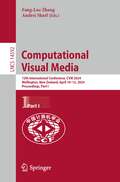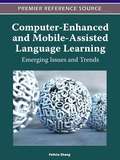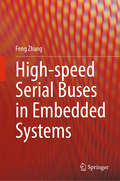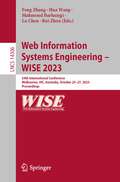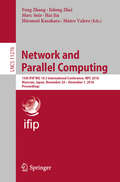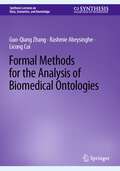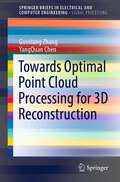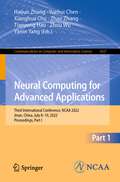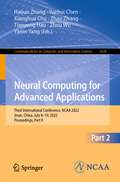- Table View
- List View
Ensemble Machine Learning: Methods and Applications
by Cha Zhang Yunqian MaIt is common wisdom that gathering a variety of views and inputs improves the process of decision making, and, indeed, underpins a democratic society. Dubbed "ensemble learning" by researchers in computational intelligence and machine learning, it is known to improve a decision system's robustness and accuracy. Now, fresh developments are allowing researchers to unleash the power of ensemble learning in an increasing range of real-world applications. Ensemble learning algorithms such as "boosting" and "random forest" facilitate solutions to key computational issues such as face recognition and are now being applied in areas as diverse as object tracking and bioinformatics. Responding to a shortage of literature dedicated to the topic, this volume offers comprehensive coverage of state-of-the-art ensemble learning techniques, including the random forest skeleton tracking algorithm in the Xbox Kinect sensor, which bypasses the need for game controllers. At once a solid theoretical study and a practical guide, the volume is a windfall for researchers and practitioners alike.
Blockchain Applications in Food Supply Chain Management: Case Studies and Implications (Contributions to Management Science)
by Chen Zhang Yu Gong Steve BrownThis book contributes to blockchain applications in food supply chain management from both theoretical and practical perspectives. By using the case study research method, it empirically investigates why and how food companies implement blockchain technology. Moreover, it proposes a conceptual framework based on the case findings and extant literature. The book provides empirical evidence to verify academic findings such as critical success factors and barriers. Furthermore, it identifies the implementation process to answer the ‘how’ question. Uniquely, it applies the innovation process model and the practice-based view (PBV) to studies on food supply chains and blockchain. Thus, building on the original model and theory, it enriches the theory on blockchain implementation, making it a valuable asset for all researchers and practitioners interested in blockchain adoption and food supply chain management.
Human Security in China: A Post-Pandemic State
by Chi ZhangThis book explores the emergent concept of 'human security' within the political context of COVID-19 Chinese politics. For decades, Western nations have used 'human rights' as a rubric with which to scold Chinese leaders, betraying a fundamental unwillingness to accept diversity of governance systems. As COVID-19 has demonstrated, different governance systems yield different outcomes—the freedom of circulation, speech and movement in Western democracies yielding one, and use of surveillance, lockdowns, and private–public collaboration in China and Asian societies such as Korea and Singapore yielding another. Chinese political scientists have become fixated on the notion of 'human security,' a utilitarian concept which insists on the importance of protecting and extending human life via health care, technology, and a wide range of other systems—sometimes, in ways which contradict Western notions of human rights, even as they demonstrably achieve superior outcomes for the humans involved. Being the first English language book to explore these issues, this book aims to generate a sustained theoretical relevance in the aftermath of the crisis which is likely to have lasting effects on how people live and will be of note for political scientists, China scholars, and economists.
Privacy-Preserving in Mobile Crowdsensing
by Chuan Zhang Tong Wu Youqi Li Liehuang ZhuMobile crowdsensing is a new sensing paradigm that utilizes the intelligence of a crowd of individuals to collect data for mobile purposes by using their portable devices, such as smartphones and wearable devices. Commonly, individuals are incentivized to collect data to fulfill a crowdsensing task released by a data requester. This “sensing as a service” elaborates our knowledge of the physical world by opening up a new door of data collection and analysis. However, with the expansion of mobile crowdsensing, privacy issues urgently need to be solved. In this book, we discuss the research background and current research process of privacy protection in mobile crowdsensing. In the first chapter, the background, system model, and threat model of mobile crowdsensing are introduced. The second chapter discusses the current techniques to protect user privacy in mobile crowdsensing. Chapter three introduces the privacy-preserving content-based task allocation scheme. Chapter four further introduces the privacy-preserving location-based task scheme. Chapter five presents the scheme of privacy-preserving truth discovery with truth transparency. Chapter six proposes the scheme of privacy-preserving truth discovery with truth hiding. Chapter seven summarizes this monograph and proposes future research directions. In summary, this book introduces the following techniques in mobile crowdsensing: 1) describe a randomizable matrix-based task-matching method to protect task privacy and enable secure content-based task allocation; 2) describe a multi-clouds randomizable matrix-based task-matching method to protect location privacy and enable secure arbitrary range queries; and 3) describe privacy-preserving truth discovery methods to support efficient and secure truth discovery. These techniques are vital to the rapid development of privacy-preserving in mobile crowdsensing.
Geospatial Semantic Web
by Chuanrong Zhang Tian Zhao Weidong LiThis book covers key issues related to Geospatial Semantic Web, including geospatial web services for spatial data interoperability; geospatial ontology for semantic interoperability; ontology creation, sharing, and integration; querying knowledge and information from heterogeneous data source; interfaces for Geospatial Semantic Web, VGI (Volunteered Geographic Information) and Geospatial Semantic Web; challenges of Geospatial Semantic Web; and development of Geospatial Semantic Web applications. This book also describes state-of-the-art technologies that attempt to solve these problems such as WFS, WMS, RDF, OWL and GeoSPARQL and demonstrates how to use the Geospatial Semantic Web technologies to solve practical real-world problems such as spatial data interoperability.
R for Programmers: Quantitative Investment Applications
by Dan ZhangAfter the fundamental volume and the advanced technique volume, this volume focuses on R applications in the quantitative investment area. Quantitative investment has been hot for some years, and there are more and more startups working on it, combined with many other internet communities and business models. R is widely used in this area, and can be a very powerful tool. The author introduces R applications with cases from his own startup, covering topics like portfolio optimization and risk management.
R for Programmers: Advanced Techniques
by Dan ZhangThis book discusses advanced topics such as R core programing, object oriented R programing, parallel computing with R, and spatial data types. The author leads readers to merge mature and effective methdologies in traditional programing to R programing. It shows how to interface R with C, Java, and other popular programing laguages and platforms.
Graph Learning in Medical Imaging: First International Workshop, GLMI 2019, Held in Conjunction with MICCAI 2019, Shenzhen, China, October 17, 2019, Proceedings (Lecture Notes in Computer Science #11849)
by Daoqiang Zhang Luping Zhou Biao Jie Mingxia LiuThis book constitutes the refereed proceedings of the First International Workshop on Graph Learning in Medical Imaging, GLMI 2019, held in conjunction with MICCAI 2019 in Shenzhen, China, in October 2019. The 21 full papers presented were carefully reviewed and selected from 42 submissions. The papers focus on major trends and challenges of graph learning in medical imaging and present original work aimed to identify new cutting-edge techniques and their applications in medical imaging.
3D Biometrics: Systems and Applications
by David Zhang Guangming LuAutomatic personal authentication using biometric information is becoming more essential in applications of public security, access control, forensics, banking, etc. Many kinds of biometric authentication techniques have been developed based on different biometric characteristics. However, most of the physical biometric recognition techniques are based on two dimensional (2D) images, despite the fact that human characteristics are three dimensional (3D) surfaces. Recently, 3D techniques have been applied to biometric applications such as 3D face, 3D palmprint, 3D fingerprint, and 3D ear recognition. This book introduces four typical 3D imaging methods, and presents some case studies in the field of 3D biometrics. This book also includes many efficient 3D feature extraction, matching, and fusion algorithms. These 3D imaging methods and their applications are given as follows: - Single view imaging with line structured-light: 3D ear identification - Single view imaging with multi-line structured-light: 3D palmprint authentication - Single view imaging using only 3D camera: 3D hand verification - Multi-view imaging: 3D fingerprint recognition 3D Biometrics: Systems and Applications is a comprehensive introduction to both theoretical issues and practical implementation in 3D biometric authentication. It will serve as a textbook or as a useful reference for graduate students and researchers in the fields of computer science, electrical engineering, systems science, and information technology. Researchers and practitioners in industry and R&D laboratories working on security system design, biometrics, immigration, law enforcement, control, and pattern recognition will also find much of interest in this book.
Electronic Nose: Algorithmic Challenges
by David Zhang Fengchun Tian Lei ZhangThis book presents the key technology of electronic noses, and systematically describes how e-noses can be used to automatically analyse odours. Appealing to readers from the fields of artificial intelligence, computer science, electrical engineering, electronics, and instrumentation science, it addresses three main areas: First, readers will learn how to apply machine learning, pattern recognition and signal processing algorithms to real perception tasks. Second, they will be shown how to make their algorithms match their systems once the algorithms don’t work because of the limitation of hardware resources. Third, readers will learn how to make schemes and solutions when the acquired data from their systems is not stable due to the fundamental issues affecting perceptron devices (e.g. sensors). In brief, the book presents and discusses the key technologies and new algorithmic challenges in electronic noses and artificial olfaction. The goal is to promote the industrial application of electronic nose technology in environmental detection, medical diagnosis, food quality control, explosive detection, etc. and to highlight the scientific advances in artificial olfaction and artificial intelligence. The book offers a good reference guide for newcomers to the topic of electronic noses, because it refers to the basic principles and algorithms. At the same time, it clearly presents the key challenges – such as long-term drift, signal uniqueness, and disturbance – and effective and efficient solutions, making it equally valuable for researchers engaged in the science and engineering of sensors, instruments, chemometrics, etc.
Pathological Voice Analysis
by David Zhang Kebin WuWhile voice is widely used in speech recognition and speaker identification, its application in biomedical fields is much less common. This book systematically introduces the authors’ research on voice analysis for biomedical applications, particularly pathological voice analysis. Firstly, it reviews the field to highlight the biomedical value of voice. It then offers a comprehensive overview of the workflow and aspects of pathological voice analysis, including voice acquisition systems, voice pitch estimation methods, glottal closure instant detection, feature extraction and learning, and the multi-audio fusion approaches. Lastly, it discusses the experimental results that have shown the superiority of these techniques. This book is useful to researchers, professionals and postgraduate students working in fields such as speech signal processing, pattern recognition, and biomedical engineering. It is also a valuable resource for those involved in interdisciplinary research.
Fundamentals of Image Data Mining: Analysis, Features, Classification and Retrieval (Texts in Computer Science)
by Dengsheng ZhangThis reader-friendly textbook presents a comprehensive review of the essentials of image data mining, and the latest cutting-edge techniques used in the field. The coverage spans all aspects of image analysis and understanding, offering deep insights into areas of feature extraction, machine learning, and image retrieval. The theoretical coverage is supported by practical mathematical models and algorithms, utilizing data from real-world examples and experiments.Topics and features: describes the essential tools for image mining, covering Fourier transforms, Gabor filters, and contemporary wavelet transforms; reviews a varied range of state-of-the-art models, algorithms, and procedures for image mining; emphasizes how to deal with real image data for practical image mining; highlights how such features as color, texture, and shape can be mined or extracted from images for image representation; presents four powerful approaches for classifying image data, namely, Bayesian classification, Support Vector Machines, Neural Networks, and Decision Trees; discusses techniques for indexing, image ranking, and image presentation, along with image database visualization methods; provides self-test exercises with instructions or Matlab code, as well as review summaries at the end of each chapter.This easy-to-follow work illuminates how concepts from fundamental and advanced mathematics can be applied to solve a broad range of image data mining problems encountered by students and researchers of computer science. Students of mathematics and other scientific disciplines will also benefit from the applications and solutions described in the text, together with the hands-on exercises that enable the reader to gain first-hand experience of computing.
Fundamentals of Image Data Mining: Analysis, Features, Classification and Retrieval (Texts in Computer Science)
by Dengsheng ZhangThis unique and useful textbook presents a comprehensive review of the essentials of image data mining, and the latest cutting-edge techniques used in the field. The coverage spans all aspects of image analysis and understanding, offering deep insights into areas of feature extraction, machine learning, and image retrieval. The theoretical coverage is supported by practical mathematical models and algorithms, utilizing data from real-world examples and experiments. Topics and features: Describes essential tools for image mining, covering Fourier transforms, Gabor filters, and contemporary wavelet transformsDevelops many new exercises (most with MATLAB code and instructions)Includes review summaries at the end of each chapterAnalyses state-of-the-art models, algorithms, and procedures for image miningIntegrates new sections on pre-processing, discrete cosine transform, and statistical inference and testingDemonstrates how features like color, texture, and shape can be mined or extracted for image representationApplies powerful classification approaches: Bayesian classification, support vector machines, neural networks, and decision treesImplements imaging techniques for indexing, ranking, and presentation, as well as database visualization This easy-to-follow, award-winning book illuminates how concepts from fundamental and advanced mathematics can be applied to solve a broad range of image data mining problems encountered by students and researchers of computer science. Students of mathematics and other scientific disciplines will also benefit from the applications and solutions described in the text, together with the hands-on exercises that enable the reader to gain first-hand experience of computing.
Resource Management for Energy and Spectrum Harvesting Sensor Networks
by Deyu Zhang Zhigang Chen Haibo Zhou Xuemin Sherman ShenThis SpringerBrief offers a comprehensive review and in-depth discussion of the current research on resource management. The authors explain how to best utilize harvested energy and temporally available licensed spectrum. Throughout the brief, the primary focus is energy and spectrum harvesting sensor networks (ESHNs) including energy harvesting (EH)-powered spectrum sensing and dynamic spectrum access. To efficiently collect data through the available licensed spectrum, this brief examines the joint management of energy and spectrum. An EH-powered spectrum sensing and management scheme for Heterogeneous Spectrum Harvesting Sensor Networks (HSHSNs) is presented in this brief. The scheme dynamically schedules the data sensing and spectrum access of sensors in ESHSNs to optimize the network utility, while considering the stochastic nature of EH process, PU activities and channel conditions. This brief also provides useful insights for the practical resource management scheme design for ESHSNs and motivates a new line of thinking for future sensor networking. Professionals, researchers, and advanced-level students in electrical or computer engineering will find the content valuable.
Genetic Programming for Production Scheduling: An Evolutionary Learning Approach (Machine Learning: Foundations, Methodologies, and Applications)
by Fangfang Zhang Su Nguyen Yi Mei Mengjie ZhangThis book introduces readers to an evolutionary learning approach, specifically genetic programming (GP), for production scheduling. The book is divided into six parts. In Part I, it provides an introduction to production scheduling, existing solution methods, and the GP approach to production scheduling. Characteristics of production environments, problem formulations, an abstract GP framework for production scheduling, and evaluation criteria are also presented. Part II shows various ways that GP can be employed to solve static production scheduling problems and their connections with conventional operation research methods. In turn, Part III shows how to design GP algorithms for dynamic production scheduling problems and describes advanced techniques for enhancing GP’s performance, including feature selection, surrogate modeling, and specialized genetic operators. In Part IV, the book addresses how to use heuristics to deal with multiple, potentially conflicting objectives in production scheduling problems, and presents an advanced multi-objective approach with cooperative coevolution techniques or multi-tree representations. Part V demonstrates how to use multitask learning techniques in the hyper-heuristics space for production scheduling. It also shows how surrogate techniques and assisted task selection strategies can benefit multitask learning with GP for learning heuristics in the context of production scheduling. Part VI rounds out the text with an outlook on the future.Given its scope, the book benefits scientists, engineers, researchers, practitioners, postgraduates, and undergraduates in the areas of machine learning, artificial intelligence, evolutionary computation, operations research, and industrial engineering.
Computational Visual Media: 12th International Conference, CVM 2024, Wellington, New Zealand, April 10–12, 2024, Proceedings, Part II (Lecture Notes in Computer Science #14593)
by Fang-Lue Zhang Andrei SharfThis book constitutes the refereed proceedings of CVM 2024, the 12th International Conference on Computational Visual Media, held in Wellington, New Zealand, in April 2024.The 34 full papers were carefully reviewed and selected from 212 submissions. The papers are organized in topical sections as follows:Part I: Reconstruction and Modelling, Point Cloud, Rendering and Animation, User Interations.Part II: Facial Images, Image Generation and Enhancement, Image Understanding, Stylization, Vision Meets Graphics.
Computational Visual Media: 12th International Conference, CVM 2024, Wellington, New Zealand, April 10–12, 2024, Proceedings, Part I (Lecture Notes in Computer Science #14592)
by Fang-Lue Zhang Andrei SharfThis book constitutes the refereed proceedings of CVM 2024, the 12th International Conference on Computational Visual Media, held in Wellington, New Zealand, in April 2024.The 34 full papers were carefully reviewed and selected from 212 submissions. The papers are organized in topical sections as follows:Part I: Reconstruction and Modelling, Point Cloud, Rendering and Animation, User Interations.Part II: Facial Images, Image Generation and Enhancement, Image Understanding, Stylization, Vision Meets Graphics.
Computer-Enhanced and Mobile-Assisted Language Learning: Emerging Issues and Trends
by Felicia ZhangAs the field of Information and Communication Technologies rapidly expands, the applications to language learning continue to grow. Computer-Enhanced and Mobile-Assisted Language Learning: Emerging Issues and Trends compiles the latest research into computer-enhanced language learning, as well as the integration of mobile devices into new language acquisition. Though new information is constantly coming out as technologies continue to evolve, this important new follow-up publication will be distributed worldwide among academic and professional institutions and will be instrumental in providing researchers, scholars, students, and professionals access to the latest knowledge related to research on computer-enhanced and mobile assisted language learning.
High-speed Serial Buses in Embedded Systems
by Feng ZhangThis book describes the most frequently used high-speed serial buses in embedded systems, especially those used by FPGAs. These buses employ SerDes, JESD204, SRIO, PCIE, Aurora and SATA protocols for chip-to-chip and board-to-board communication, and CPCIE, VPX, FC and Infiniband protocols for inter-chassis communication. For each type, the book provides the bus history and version info, while also assessing its advantages and limitations. Furthermore, it offers a detailed guide to implementing these buses in FPGA design, from the physical layer and link synchronization to the frame format and application command. Given its scope, the book offers a valuable resource for researchers, R&D engineers and graduate students in computer science or electronics who wish to learn the protocol principles, structures and applications of high-speed serial buses.
Web Information Systems Engineering – WISE 2023: 24th International Conference, Melbourne, VIC, Australia, October 25–27, 2023, Proceedings (Lecture Notes in Computer Science #14306)
by Feng Zhang Hua Wang Mahmoud Barhamgi Lu Chen Rui ZhouThis book constitutes the proceedings of the 24th International Conference on Web Information Systems Engineering, WISE 2023, held in Melbourne, Victoria, Australia, in October 2023.The 33 full and 40 short papers were carefully reviewed and selected from 137 submissions. They were organized in topical sections as follows: text and sentiment analysis; question answering and information retrieval; social media and news analysis; security and privacy; web technologies; graph embeddings and link predictions; predictive analysis and machine learning; recommendation systems; natural language processing (NLP) and databases; data analysis and optimization; anomaly and threat detection; streaming data; miscellaneous; explainability and scalability in AI.
Network and Parallel Computing: IFIP International Conference, NPC 2007, Dalian, China, September 18-21, 2007, Proceedings (Lecture Notes in Computer Science #4672)
by Feng Zhang Jidong Zhai Marc Snir Hai Jin Hironori Kasahara Mateo ValeroThis book constitutes the proceedings of the 15th IFIP International Conference on Network and Parallel Computing, NPC 2018, held in Muroran, Japan, in November/December 2018. <P><P>The 22 full and 12 short papers presented in this volume were carefully reviewed and selected from 72 submissions. The papers cover traditional areas of network and parallel computing, including parallel applications, distributed algorithms, parallel architectures, software environments, and distributed tools.
Formal Methods for the Analysis of Biomedical Ontologies (Synthesis Lectures on Data, Semantics, and Knowledge)
by Guo-Qiang Zhang Rashmie Abeysinghe Licong CuiThe book synthesizes research on the analysis of biomedical ontologies using formal concept analysis, including through auditing, curation, and enhancement. As the evolution of biomedical ontologies almost inevitably involves manual work, formal methods are a particularly useful tool for ontological engineering and practice, particularly in uncovering unexpected "bugs" and content materials. The book first introduces simple but formalized strategies for discovering undesired and incoherent patterns in ontologies before exploring the application of formal concept analysis for semantic completeness. The book then turns to formal concept analysis, a classical approach used in the mathematical treatment of orders and lattices, as an ontological engineering principle, focusing on the structural property of ontologies with respect to its conformation to lattice or not (non-lattice). The book helpfully covers the development of more efficient algorithms for non-lattice detection and extraction required by exhaustive lattice/non-lattice analysis. The book goes on to highlight the power and utility of uncovering non-lattice structure for debugging ontologies and describes methods that leverage the linguistic information in concept names (labels) for ontological analysis. It also addresses visualization and performance evaluation issues before closing with an overview and forward-looking perspectives on the field. This book is intended for graduate students and researchers interested in biomedical ontologies and their applications. It can be a useful supplement for courses on knowledge representation and engineering and also provide readers with a reference for related scientific publications and literature to assist in identifying potential research topics. All mathematical concepts and notations used in this book can be found in standard discrete mathematics textbooks, and the appendix at the end of the book provides a list of key ontological resources, as well as annotated non-lattice and lattice examples that were discovered using the authors' methods, demonstrating how "bugs are fixed" by converting non-lattices to lattices with minimal edit changes.
Towards Optimal Point Cloud Processing for 3D Reconstruction (SpringerBriefs in Electrical and Computer Engineering)
by Guoxiang Zhang YangQuan ChenThis SpringerBrief presents novel methods of approaching challenging problems in the reconstruction of accurate 3D models and serves as an introduction for further 3D reconstruction methods. It develops a 3D reconstruction system that produces accurate results by cascading multiple novel loop detection, sifting, and optimization methods.The authors offer a fast point cloud registration method that utilizes optimized randomness in random sample consensus for surface loop detection. The text also proposes two methods for surface-loop sifting. One is supported by a sparse-feature-based optimization graph. This graph is more robust to different scan patterns than earlier methods and can cope with tracking failure and recovery. The other is an offline algorithm that can sift loop detections based on their impact on loop optimization results and which is enabled by a dense map posterior metric for 3D reconstruction and mapping performance evaluation works without any costly ground-truth data. The methods presented in Towards Optimal Point Cloud Processing for 3D Reconstruction will be of assistance to researchers developing 3D modelling methods and to workers in the wide variety of fields that exploit such technology including metrology, geological animation and mass customization in smart manufacturing.
Neural Computing for Advanced Applications: Third International Conference, NCAA 2022, Jinan, China, July 8–10, 2022, Proceedings, Part I (Communications in Computer and Information Science #1637)
by Haijun Zhang Yuehui Chen Xianghua Chu Zhao Zhang Tianyong Hao Zhou Wu Yimin YangThe two-volume Proceedings set CCIS 1637 and 1638 constitutes the refereed proceedings of the Third International Conference on Neural Computing for Advanced Applications, NCAA 2022, held in Jinan, China, during July 8–10, 2022. The 77 papers included in these proceedings were carefully reviewed and selected from 205 submissions. These papers were categorized into 10 technical tracks, i.e., neural network theory, and cognitive sciences, machine learning, data mining, data security & privacy protection, and data-driven applications, computational intelligence, nature-inspired optimizers, and their engineering applications, cloud/edge/fog computing, the Internet of Things/Vehicles (IoT/IoV), and their system optimization, control systems, network synchronization, system integration, and industrial artificial intelligence, fuzzy logic, neuro-fuzzy systems, decision making, and their applications in management sciences, computer vision, image processing, and their industrial applications, natural language processing, machine translation, knowledge graphs, and their applications, Neural computing-based fault diagnosis, fault forecasting, prognostic management, and system modeling, and Spreading dynamics, forecasting, and other intelligent techniques against coronavirus disease (COVID-19).
Neural Computing for Advanced Applications: Third International Conference, NCAA 2022, Jinan, China, July 8–10, 2022, Proceedings, Part II (Communications in Computer and Information Science #1638)
by Haijun Zhang Yuehui Chen Xianghua Chu Zhao Zhang Tianyong Hao Zhou Wu Yimin YangThe two-volume Proceedings set CCIS 1637 and 1638 constitutes the refereed proceedings of the Third International Conference on Neural Computing for Advanced Applications, NCAA 2022, held in Jinan, China, during July 8–10, 2022. The 77 papers included in these proceedings were carefully reviewed and selected from 205 submissions. These papers were categorized into 10 technical tracks, i.e., neural network theory, and cognitive sciences, machine learning, data mining, data security & privacy protection, and data-driven applications, computational intelligence, nature-inspired optimizers, and their engineering applications, cloud/edge/fog computing, the Internet of Things/Vehicles (IoT/IoV), and their system optimization, control systems, network synchronization, system integration, and industrial artificial intelligence, fuzzy logic, neuro-fuzzy systems, decision making, and their applications in management sciences, computer vision, image processing, and their industrial applications, natural language processing, machine translation, knowledge graphs, and their applications, Neural computing-based fault diagnosis, fault forecasting, prognostic management, and system modeling, and Spreading dynamics, forecasting, and other intelligent techniques against coronavirus disease (COVID-19).
